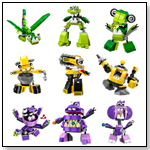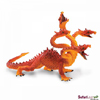|
|
Activision is undergoing fundamental change – and none too soon! Activision’s core business – video games played on consoles – has been struggling for the past four years. Their two main products – World of War Craft and Call of Duty – continue to be caught in the transition from consoles to smartphones. What does not help either is the rapid rise of the casual gamer who is not an aficionado of hard core games in general and of Call of Duty in particular. Whatever the reasons for the decline in Activision’s main products are, there is no question that there is a decline. First, World of Warcraft: 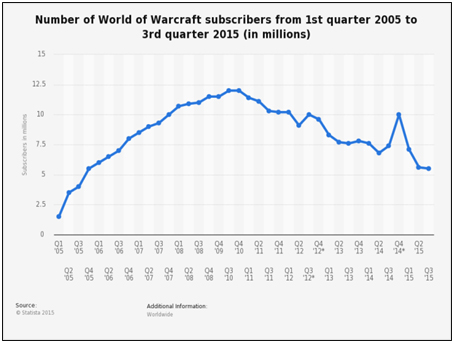 While the chart above only goes to the end of the third quarter, all indications are that the subscriber number continued to decline to an estimated 5 million by end of 2015. Worse, it looks probable that this decline is very likely to continue and will not be reversed by the forthcoming release of World of Warcraft: Legion on September 21, 2016. The picture is not looking much better for the other major driver – Call of Duty. This is how sales developed: 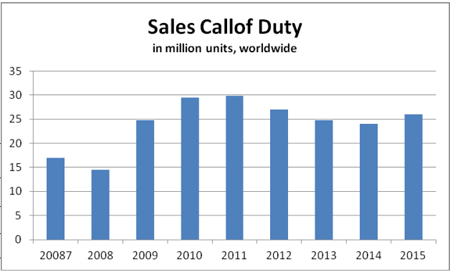 Source NPD Call of Duty Black Ops 3 was very successful and captured the #1 video game sales position as per NPD both for December as well as for the whole 2015 year and hence could at least temporarily reverse the negative trend in place since 2011. The question now arises as to what will happen in 2016. Most national buyers I spoke to think that it will be Call of Duty Ghosts 2, following the somewhat disappointing Ghosts 1 in 2013. They also think that it is somewhat unlikely that either Ghosts 2 or any other Call of Duty game will in 2016 repeat or even surpass the success enjoyed by Black Ops 3. Despite the very clear success of Black Ops 3, the company lost significant market share in the U.S. in the three months between October 2015 and January 2016: 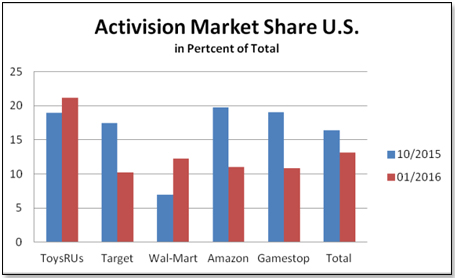 Source: Klosters Retailer Panel The more extended outlook for 2016 is not much better, at least during the first two quarters, given that the company really has very little in new games to offer compared to their leading competitors: 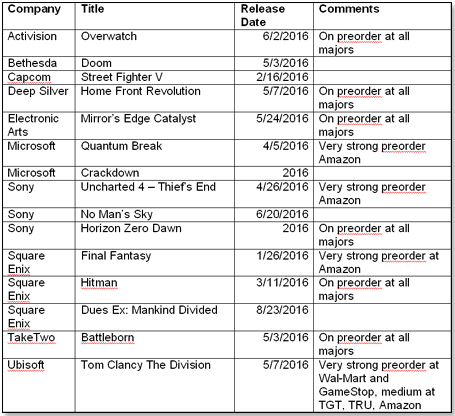 Source: Klosters Retailer Panel In other words, the only new game on the horizon is Overwatch. My contacts tell me that Overwatch is in fact not all that new – it apparently is a redo of Project Titan which was axed in 2014 because of insufficiently positive focus group feedback. Whatever the case may be, Overwatch is on preorder but the numbers so far are not particularly great. Against this background, the company was either very lucky or very foresighted when they launched in October 2011 the Skylanders which gave them a very successful entry into the toy category. Without that entry, their overall business would have declined as the chart below shows: 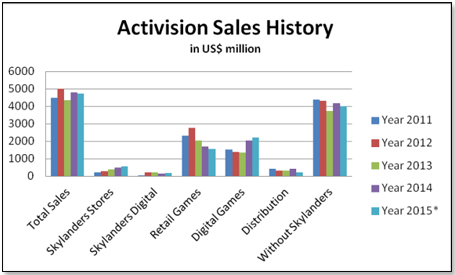 Source: SEC Filings However, not all is rosy for the Skylanders either. The Skylanders business model has since the beginning been to target the Action Figure category of the traditional toy market. The company recognized that they would come under pretty ferocious attach by two new entrants – the Disney Infinity Star Wars range released at the end of August 2015 and then Lego Dimensions a month later. To offset this competitive threat they had decided to pivot at least partly away from their Action Figure focus in favour of another toy category – Vehicles – through their Superchargers released late September. However, this pivot came too late and was not executed strongly enough to neutralize these new competitors. The end effect was that the Skylanders during the all-important fourth quarter ended up flat: 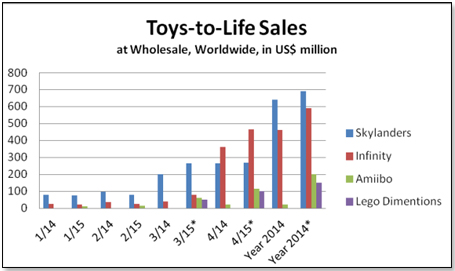 Source: Klosters Retailer Panel Infinity continued to accelerate throughout the first half of January and this is expected by the national buyers to continue throughout the first quarter. Also, Lego Dimensions continues to gain market share and the expectation is that the Skylanders will see a decline in the order of about 10% between January and March 2016. Activision is apparently planning yet another pivot to the Skylanders for late 2016 with Battlecast - a competitive card game for Android and iOS devices that will allow players to purchase real physical cards – pretty much like what we now know as trading cards. However, thereby lies a problem. The majority of the trading card business is done in the Game and Hobby channel, about 5000 small one- to two-door establishments that cater to a very devoted consumer group and who typically buy their products from semi-wholesalers who buy from wholesalers who buy from the companies they have relationships with – Hasbro’s Wizards of the Coast, Konami’s Yu Gi Oh, Pokemon and others. Activision at this point would find it very difficult and time consuming to create the supply chain to these stores and would hence be restricted to the in this particular category much less important mass retailers such as ToysRUs to place their products. It is against this background that we have to consider the three recent very significant initiatives taken by Activision. · On November 2, 2015, the company bought King Digital Entertainment, the owner of Candy Crush Saga and another 10 games, all mobile. Sales for the fiscal year ending on December 31, 2015, are estimated at $2 billion, down from $2.28 billion in 2014. There are indications that King Digital is expanding its offering by moving also into the mid-core genre in order to compete with Supercell and Machine Zone who are generating very significant revenue streams from such mid-core mobile games as Game of War, BoomBeach and Clash of Clans. Mid-core games basically occupy the middle ground between purely casual games such as Candy Crush on one side and shooters such as Call of Duty on the other. The addition of King’s highly-complementary business will position Activision Blizzard as a global leader in interactive entertainment across mobile, console and PC platforms, and establishes it as a leader in the rapidly growing mobile game segment. In fact, mobile games are expected to grow about 20% worldwide this year, to about $20 billion, which gives Activision an approximate 10% market share. Incidentally, this 20% growth rate compares to the expected 7% growth rate for computer games and 2% for TV and console games this year, according to research firm Newzoo. Ticker Tags demonstrate the relative importance of mobile games versus console-based products in the eyes of the consumer:  Source: Ticker Tags · On November 4, 2015, ATVI announced that they had launched the Activision Blizzard Studios, an in-house film and television studio devoted to creating original movies and TV shows based on the company’s video games. In so doing, the company has adopted a multi-media approach that leverages its proprietary IP content over a variety of entertainment channels. Their content is extremely significant because it includes such very strong brands as Call of Duty, Skylanders, Diablo and others.. This is a strategically very important step for two reasons. One is that a movie based on a video game has proven that it can be very successful – CapCom’s Resident Evil released in September 2012 racked up a box office worldwide of $240 million; EA’s Need for Speed launched in March 2014 did $203 million. The second is that , unlike EA and Capcom, Activision has through its Skylanders franchise a ready-made entry into the most important retailers. If you take into account the fact that Hasbro racked up sales of about $2 billion for the Transformer action figures on the back of the last three Transformer movies, you can see why there is a major opportunity for Activision to enter the toy market in conjunction with movies developed by this new studio. And they seem to mean business as demonstrated that they recruited Nick van Dyk from Disney to co-head this new venture. · On January 4, 2016, Activision bought Major League Gaming [MLG] with the avowed intention to "build the ESPN of video games" -- a premium cable TV channel dedicated exclusively to gaming. MLG.tv is an online broadcast network for professional-level E-sports and the MLG Pro Circuit is the longest-running E-sports league in North America. GameBattles, a site owned by MLG, is the largest online gaming tournament system across consoles, PC and mobile platforms. This acquisition provides ATVI with an entry into the E-Sporting world which has experienced rapid growth in the last few years, taking in $612 million in revenue in 2015. Streaming audience numbers for the genre have been estimated to have reached the 100 million mark in 2015. This number is expected to grow to 300 million worldwide by 2017, according to Activision. Activision will merge MLG with its in-house E-sports division, Activision Blizzard Media Networks. The end effect of these three moves is that it is probable to transform Activision from a video game publisher who through the Skylanders also has a foothold in the toy industry to a very major entertainment powerhouse and potentially the largest video game company worldwide. The company could thus well emerge not only as the major player in video games but also as a significant factor in the toy industry as well as in the overall entertainment sector.  Writer's Bio: Lutz Muller is a Swiss who has lived on five continents. In the United States, he was the CEO for four manufacturing companies, including two in the toy industry. Since 2002, he has provided competitive intelligence on the toy and video game market to manufacturers and financial institutions coast-to-coast. He gets his information from his retailer panel, from big-box buyers and his many friends in the industry. If anything happens, he is usually the first to know. Read more on his website at www.klosterstrading.com. Read more articles by this author Writer's Bio: Lutz Muller is a Swiss who has lived on five continents. In the United States, he was the CEO for four manufacturing companies, including two in the toy industry. Since 2002, he has provided competitive intelligence on the toy and video game market to manufacturers and financial institutions coast-to-coast. He gets his information from his retailer panel, from big-box buyers and his many friends in the industry. If anything happens, he is usually the first to know. Read more on his website at www.klosterstrading.com. Read more articles by this author |
| ||||||||||||||||||||||||||||||||
Disclaimer Privacy Policy Career Opportunities
Use of this site constitutes acceptance of our Terms of Use.
© Copyright 2025 PlayZak®, a division of ToyDirectory.com®, Inc.


